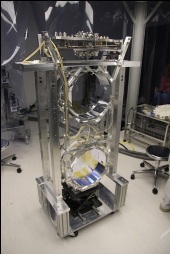Installation of the First Fused Silica Monolithic Suspension at LIGO Hanform
Published: 4 January 2012
The search for gravitational waves relies on measuring the minute motion of massive mirrors. This requires the mirrors to be isolated from everyday vibrations and hence they are hung by systems of controlled wires - a bit like a puppet!
 Advanced LIGO passed a significant milestone in November 2011 when an international team successfully suspended a 40 kg mirror from four thin glass fibres in a quadruple suspension at the LIGO Hanford gravitational wave observatory in the United States.
Advanced LIGO passed a significant milestone in November 2011 when an international team successfully suspended a 40 kg mirror from four thin glass fibres in a quadruple suspension at the LIGO Hanford gravitational wave observatory in the United States.
The Research and Development necessary to suspend the mass was developed by physicists in the Institute for Gravitational Research (IGR) and has resulted in a robust, well engineered, solution highly commended by the National Science Foundation in the United States. This is the first of twelve monolithic suspensions that LIGO must assemble for the advanced detectors. The UK-German GEO600 detector was the first to pioneer fused silica suspensions, and the upscaling of the technique to the larger Advanced LIGO optics represents a significant technological step forward for gravitational wave detectors. The implementation of glass suspensions will decrease the thermal noise on the mirrors which is a fundamental noise source at low frequency. Members of the IGR will continue to provide support for all the future installations and also perform detailed Finite Element modelling of the thermal noise performance which will ultimately be compared with data from the suspensions.
More information about this work can be found in a paper recently published in Classical and Quantum Gravity; “Design and development of the advanced LIGO monolithic fused silica suspension”, Classical and Quantum Gravity, 29 (2012) 035003”.
First published: 4 January 2012
<< 2012 archive

